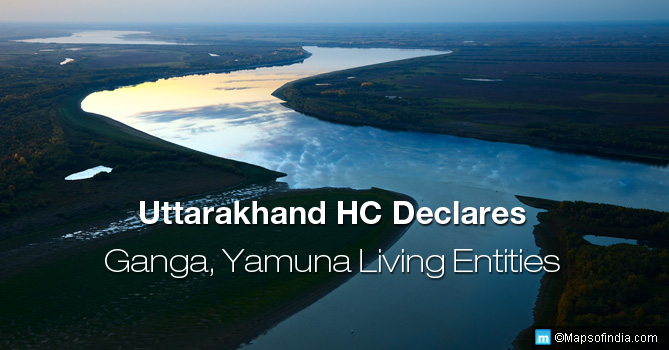It has been about a week since New Zealand legislators passed a legislation that granted the Whanganui River the status of a “legal person”. The Whanganui, a river sacred to the native Maori tribe, was given “its own legal identity with all the corresponding rights, duties and liabilities of a legal person”.
The move, a first in the world, was hailed by environmentalists and people from across the globe.
Ganga and Yamuna: Living Entities
Not far behind, the Uttarakhand High Court recognised River Ganga (the Ganges) as the “first living entity of India”. The court also directed the government to form an administrative board that would look after the cleaning activities and undertake maintenance of the river.
Ganga is the longest flowing river in the country. While Indus and Brahmaputra may be longer, the distances they traverse in India are short. Along with Ganga, River Yamuna has also been granted the status of a living entity. Both the rivers will be accorded all the legal rights and responsibilities, same as that of an Indian citizen.
The rivers will have rights that will be safeguarded by a representative, and are vulnerable to complaints against them just as any other person would be.
Namami Gange
For centuries now, the river Ganga has been treated as a divine being – a sacred entity – by the Hindus. She is believed to be the cleanser of sins and to die on her banks grants one absolution from the cycle of birth and death, as per Hindus.
Perhaps the origin of this belief lies in the fact that the vast and very fertile alluvial plain of northern India owes its prosperity, and even its very existence, to the river. The river and its tributaries provide natural irrigation to over 5,80,000 sq. kilometres of arable land, which makes up a third of all the cultivable land in the country.
It also provides drinking water to almost all of northern and eastern India. The Ganga basin yields a great deal of rice, wheat, lentils, potatoes, sugarcane, and oil seeds.
Despite its importance, the Ganga has been polluted by the population living along its basin. The National Mission for Clean Ganga (NMCG) was set up in 2011, but work picked pace in 2014 when the Narendra Modi government set up the ‘Namami Gange’ project with a budget of Rs 20,000 crore. The project aims to clean up the water of the river and preserve the rich biodiversity in the Ganga basin.
The Ruling and Its Implications
The Uttarakhand High Court division bench comprising Justice Rajiv Sharma and Justice Alok Singh said that this “extraordinary situation has arisen since the rivers Ganga and the Yamuna are losing their very existence…The rivers are central to the existence of half of the Indian population and their health and wellbeing. They have provided both physical and spiritual sustenance to all of us from time immemorial”.
The full implications of the ruling are yet to be understood in a legal context, but it seems apparent that any person, organisation, or corporation found polluting the waters of these two rivers will be booked under relevant laws and punished.
Dumping of untreated waste into the rivers will now have to cease completely. This will make state governments, municipal corporations, and private corporations take up responsibility for setting up waste treatment plants along the two rivers.
We’re yet to find out if this ruling leaves the rivers open to suit in case of natural calamities, or accidents. There is no information yet about the trading rights of the river, i.e., whether or not the water and natural resources provided by the rivers are considered tradable commodities. The ruling is certain to bring a great cheer to the environmentalists who have been concerned about the pollution and conservation of flora and fauna in the Ganga basin.
The judges urged both the governments of Uttar Pradesh and Uttarakhand to cooperate with the Ministry of Water Resources and Ganga Rejuvenation, in constituting the Ganga Management Board. The central government has been given a three-month deadline to make the board functional.





